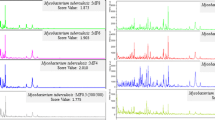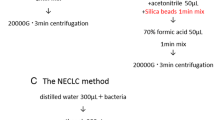Abstract
We assessed the performance of the VITEK® MS IVD V3.0 matrix-assisted laser desorption ionization - time of flight mass spectrometry (MALDI-ToF MS) V3.0 database for the identification of Nocardia spp. as compared with targeted DNA sequencing. A collection of 222 DNA sequence-defined Nocardia spp. strains encompassing 18 different species present or not in the database was tested. Bromocresol purple agar (BCP) and Columbia agar +5% sheep’s blood (COS) culture media were used together with two different preparation steps: direct smear and a “3 attempts” procedure that covered (1) spotting of an extract, (2) new spotting of the same extract, and (3) spotting of a new extract. The direct smear protocol yielded low correct identification rates (≤ 15% for both media) whereas protein extraction yielded correct identification results (> 67% regardless of the media used.). The use of 2 additional attempts using repeat or new extracts increased correct identification rates to 87% and 91% for BCP and COS, respectively. When using the 3 attempts procedure, the best identification results, independent of media types, were obtained for N. farcinica and N. cyriacigeorgica (100%). Identification attempts 2 and 3 allowed to increase the number of correct identifications (BCP, +20%; COS, +13%). The enhancement in performance during attempts 2 and 3 was remarkable for N. abscessus (81% for both media) and low prevalence species (BCP, 70%; COS, 85%). Up to 3.4% and 2.4% of the strains belonging to species present in the database were misidentified with BCP and COS media, respectively. In 1.9% of the cases for BCP and 1.4% for COS, these misidentifications concerned a species belonging to the same phylogenetic complex. Concerning strains that are not claimed in the V3.0 database, N. puris and N. goodfellowi generated “No identification” results and 100% of the strains belonging to N. arthritidis, N. cerradoensis, and N. altamirensis yielded a misidentification within the same phylogenetic complex. Vitek® MS IVD V3.0 is an accurate and useful tool for identification of Nocardia spp.

Similar content being viewed by others
References
Conville PS, Brown-Elliott BA, Smith T, Zelazny AM (2017) The complexities of Nocardia taxonomy and identification. J Clin Microbiol 56:e01419–e01417. https://doi.org/10.1128/JCM.01419-17
Haussaire D, Fournier P-E, Djiguiba K, Moal V, Legris T, Purgus R, Bismuth J, Elharrar X, Reynaud-Gaubert M, Vacher-Coponat H (2017) Nocardiosis in the south of France over a 10-years period, 2004–2014. Int J Infect Dis 57:13–20. https://doi.org/10.1016/j.ijid.2017.01.005
Le Coustumier EM, Denes E, Martin C, Weinbreck P (2017) Nocardiose : analyse rétrospective d’une série de 19 cas. Rev Médecine Interne 38:81–89. https://doi.org/10.1016/j.ijid.2017.01.005
Wilson JW (2012) Nocardiosis: updates and clinical overview. Mayo Clin Proc 87:403–407. https://doi.org/10.1016/j.mayocp.2011.11.016
Anagnostou T, Arvanitis M, Kourkoumpetis TK, Desalermos A, Carneiro HA, Mylonakis E (2014) Nocardiosis of the central nervous system: experience from a general hospital and review of 84 cases from the literature. Medicine (Baltimore) 93:19–32. https://doi.org/10.1097/MD.0000000000000012
Jiang Y, Huang A, Fang Q (2016) Disseminated nocardiosis caused by Nocardia otitidiscaviarum in an immunocompetent host: a case report and literature review. Exp Ther Med 12:3339–3346. https://doi.org/10.3892/etm.2016.3755
Liu WL, Lai CC, Ko WC, Chen YH, Tang HJ, Huang YL, Huang YT, Hsueh PR (2011) Clinical and microbiological characteristics of infections caused by various Nocardia species in Taiwan: a multicenter study from 1998 to 2010. Eur J Clin Microbiol Infect Dis 30:1341–1347. https://doi.org/10.1007/s10096-011-1227-9
Munoz J, Mirelis B, Aragon LM, Gutierrez N, Sanchez F, Espanol M, Esparcia O, Gurguí M, Domingo P, Coll P (2007) Clinical and microbiological features of nocardiosis 1997-2003. J Med Microbiol 56:545–550. https://doi.org/10.1099/jmm.0.46774-0
Valdezate S, Garrido N, Carrasco G, Medina-Pascual MJ, Villalón P, Navarro AM, Saéz-Nieto JA (2017) Epidemiology and susceptibility to antimicrobial agents of the main Nocardia species in Spain. J Antimicrob Chemother 1:754–761. https://doi.org/10.1093/jac/dkw489
Brown-Elliott BA, Brown JM, Conville PS, Wallace RJ (2006) Clinical and laboratory features of the Nocardia spp. based on current molecular taxonomy. Clin Microbiol Rev 19:259–282. https://doi.org/10.1128/CMR.19.2.259-282.2006
Xiao M, Pang L, Chen SC-A, Fan X, Zhang L, Li H-X, Hou X, Cheng J-W, Kong F, Zhao Y-P (2016) Accurate identification of common pathogenic Nocardia species: evaluation of a multilocus sequence analysis platform and matrix-assisted laser desorption ionization-time of flight mass spectrometry. PLOS ONE 11(1):e0147487. https://doi.org/10.1371/journal.pone.0147487
McTaggart LR, Richardson SE, Witkowska M, Zhang SX (2010) Phylogeny and identification of Nocardia species on the basis of multilocus sequence analysis. J Clin Microbiol 48:4525–4533. https://doi.org/10.1128/JCM.00883-10
Buckwalter SP, Olson SL, Connelly BJ, Lucas BC, Rodning AA, Walchak RC, Deml SM, Wohlfiel SL, Wengenack NL (2016) Evaluation of matrix-assisted laser desorption ionization−time of flight mass spectrometry for identification of mycobacterium species, Nocardia species, and other aerobic actinomycetes. J Clin Microbiol 54:376–384. https://doi.org/10.1128/JCM.02128-15
Segawa S, Nishimura M, Sogawa K, Tsuchida S, Murata S, Watanabe M, Matsushita K, Kamei K, Nomura F (2015) Identification of Nocardia species using matrix-assisted laser desorption/ionization–time-of-flight mass spectrometry. Clin Proteomics 12:6. https://doi.org/10.1186/s12014-015-9078-5
Marín M, Ruiz A, Iglesias C, Quiroga L, Cercenado E, Martín-Rabadán P, Bouza E, Rodríguez-Sánchez B (2018) Identification of Nocardia species from clinical isolates using MALDI-TOF mass spectrometry. Clin Microbiol Infect 24(12):1342.e5–1342.e8. https://doi.org/10.1016/j.cmi.2018.06.014
Girard V, Mailler S, Welker M, Arsac M, Cellière B, Cotte-Pattat P-J, Chatellier S, Durand G, Béni AM, Schrenzel J, Miller E, Dussoulier R, Dunne WM Jr, Butler-Wu S, Saubolle MA, Sussland D, Bell M, van Belkum A, Deol P (2016) Identification of Mycobacterium spp. and Nocardia spp. from solid and liquid cultures by matrix-assisted laser desorption ionization–time of flight mass spectrometry (MALDI-TOF MS). Diagn Microbiol Infect Dis 86:277–283. https://doi.org/10.1016/j.diagmicrobio.2016.07.027
Girard V, Mailler S, Polsinelli S, Jacob D, Saccomani MC, Celliere B, Monnin V, van Belkum A, Hagen F, Meis JF, Durand G (2017) Routine identification of Nocardia species by MALDI-TOF mass spectrometry. Diagn Microbiol Infect Dis 87:7–10. https://doi.org/10.1016/j.diagmicrobio.2016.09.024
Body BA, Beard MA, Slechta ES, Hanson KE, Barker AP, Babady NE, McMillen T, Tang YW, Brown-Elliott BA, Iakhiaeva E, Vasireddy R, Vasireddy S, Smith T, Wallace RJ Jr, Turner S, Curtis L, Butler-Wu S, Rychert J (2018) Evaluation of the Vitek MS v3.0 matrix-assisted laser desorption ionization–time of flight mass spectrometry system for identification of Mycobacterium and Nocardia species. J Clin Microbiol. https://doi.org/10.1128/JCM.00237-18
Lebeaux D, Bergeron E, Berthet J, Djadi-Prat J, Mouniée D, Boiron P, Lortholary O, Rodriguez-Nava V (2019) Antibiotic susceptibility testing and species identification of Nocardia isolates: a retrospective analysis of data from a French expert laboratory, 2010-2015. Clin Microbiol Infect 25:489–495. https://doi.org/10.1016/j.cmi.2018.06.013
Rodriguez-Nava V, Couble A, Devulder G, Flandrois J-P, Boiron P, Laurent F (2006) Use of PCR-restriction enzyme pattern analysis and sequencing database for hsp65 gene-based identification of Nocardia species. J Clin Microbiol 44:536–546
CLSI (2008) MM18-A: interpretive criteria for identification of bacteria and fungi by DNA target sequencing, 1st edn. CLSI, Wayne
Yarbrough ML, Lainhart W, Burnham C-AD (2017) Identification of Nocardia, Streptomyces, and Tsukamurella using MALDI-TOF MS with the Bruker Biotyper. Diagn Microbiol Infect Dis 89:92–97. https://doi.org/10.1016/j.diagmicrobio.2017.06.019
Verroken A, Janssens M, Berhin C, Bogaerts P, Huang T-D, Wauters G, Glupczynski Y (2010) Evaluation of matrix-assisted laser desorption ionization-time of flight mass spectrometry for identification of Nocardia species. J Clin Microbiol 48:4015–4021. https://doi.org/10.1128/JCM.01234-10
Khot PD, Bird BA, Durrant RJ, Fisher MA (2015) Identification of Nocardia species by matrix-assisted laser desorption ionization–time of flight mass spectrometry. Land GA, éditeur. J Clin Microbiol 53:3366–3369. https://doi.org/10.1128/JCM.00780-15
McTaggart LR, Chen Y, Poopalarajah R, Kus JV (2018) Incubation time and culture media impact success of identification of Nocardia spp. by MALDI-ToF mass spectrometry. Diagn Microbiol Infect Dis 92:270–274. https://doi.org/10.1016/j.diagmicrobio.2018.06.016
Tamura T, Ohji S, Ichikawa N, Hosoyama A, Yamazoe A, Hamada M et al (2018) Reclassification of Nocardia species based on whole genome sequence and associated phenotypic data. J Antibiot (Tokyo) 71:633–641
Gilquin JM, Riviere B, Jurado V, Audouy B, Kouatche JB, Bergeron E, Mouniée D, Molina T, Faure P, Saiz-Jimenez C, Rodríguez-Nava V (2016) First case of actinomycetoma in France due to a novel Nocardia species, Nocardia boironii sp. nov. mSphere 1(6). https://doi.org/10.1128/mSphere.00309-16
Iona E, Giannoni F, Brunori L, de Gennaro M, Mattei R, Fattorini L (2007) Isolation of Nocardia asiatica from cutaneous ulcers of a human immunodeficiency virus-infected patient in Italy. J Clin Microbiol 45:2088–2089. https://doi.org/10.1128/JCM.00263-07
Brown-Elliott BA, Killingley J, Vasireddy S, Bridge L, Wallace RJ Jr (2016) In vitro comparison of ertapenem, meropenem, and imipenem against isolates of rapidly growing Mycobacteria and Nocardia by use of broth microdilution and etest. J Clin Microbiol 54:1586–1592. https://doi.org/10.1128/JCM.00298-16
Funding
Florian VAUTRIN held a doctoral fellowship from the Region Auvergne-Rhône-Alpes. This study was funded by the VITEK® MS manufacturer (bioMérieux, R&D Microbiologie, La Balme-Les-Grottes, France).
Author information
Authors and Affiliations
Corresponding author
Ethics declarations
Disclaimer
The data analysis described here was performed without direct commercial influence by the device manufacturer.
Additional information
Publisher’s note
Springer Nature remains neutral with regard to jurisdictional claims in published maps and institutional affiliations.
Rights and permissions
About this article
Cite this article
Durand, T., Vautrin, F., Bergeron, E. et al. Assessment of VITEK® MS IVD database V3.0 for identification of Nocardia spp. using two culture media and comparing direct smear and protein extraction procedures. Eur J Clin Microbiol Infect Dis 39, 559–567 (2020). https://doi.org/10.1007/s10096-019-03758-x
Received:
Accepted:
Published:
Issue Date:
DOI: https://doi.org/10.1007/s10096-019-03758-x




